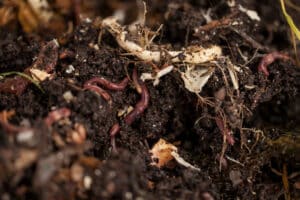Nov 12, 2025



A tractor runs because of the engine inside of it. While growers may change the oil, or do regular maintenance to keep everything working properly, if your tractor engine doesn’t have all the parts it needs it won’t run. Your soil is similar when it comes to your crop yields.
Beneath the surface of all farm soil should be a microbiome, full of life (fungi and bacteria) and working in a symbiotic relationship to support your crops. While you may have been giving your crops the regular maintenance they need, like fertilizer or water, you also must give soil microbes the maintenance they need, too.
Crops and microbes have a symbiotic relationship, essential to the success of your harvest. If your microbes are “sleeping on the job”, your crops won’t grow as well as they could, if at all.
When growers support beneficial microbes, they increase soil aggregation, increase water holding capacity, ward off pathogens, reduce abiotic stress, promote nutrient cycling and increase crop yield potential.

Soil microbes are microscopic organisms that live in soil that cannot be seen by the naked eye. Some common types include bacteria, fungi and protozoa. They perform vital functions in the soil ecosystem including:
They are essential for soil health and ecosystem stability. Your soil has the potential to harbor a billion bacteria and a million fungi in a single teaspoon of soil.
Soil microbes are normally found around living roots, as crops provide the food needed for their survival. However microbes can also be found in soils that are distant from the root zone (bulk soil). In the root zone, there’s often a higher concentration and higher diversity of beneficial microbes. This area is called the rhizosphere. It provides an ideal habitat for the symbiotic relationship of beneficial soil microbes and roots to work together.
Soil microbes are also usually found within the first few inches of the soil and at the topsoil level, where debris like leaves or fallen crops begin to decompose.

There are many different things that can impact the amount and diversity of your farm’s microbiome, including the:
*Microbial populations can double every 10-degree Fahrenheit temperature increase
As an example, tall grasslands have deep, fibrous roots where 50% of the root dies and is replaced each year. Due to the constant regeneration of roots, grasslands have high soil organic matter throughout their profile. These roots are high in sugars and proteins, which can help feed the soil microbes.
Essentially, ideal conditions for microbes include high nutrient availability in your soil temperatures above 48 degrees Fahrenheit, and appropriate moisture level, which leads to greater microbial activity and in turn, better soil structure. Microbe abundance is proportional (often) to the organic matter in the soil.
Soil organic matter is all living and nonliving carbon-based materials. This includes plant residue, compounds released from plant roots and dead microorganisms.

Many studies suggest certain soil microbes can improve soil health and crop yield potential. They can impact yield potential through:
Microbiome abundance is important to the diversity of the microbiome and plays a key role in plant and soil health. Here are the four main ways soil microbes support higher yields.
Bacteria secrete extracellular polymeric substances (EPS) or biological glues. Fungi have a hyphae (nets) root structure. Both glues and nets improve aggregates and soil structure by physically gluing together soil particles and hyphae, creating a net-like structure underground by tying soil particles together. Their presence promotes soil aggregation, soil aeration, reduced compaction, water infiltration and penetration.
All of which supports root growth and yield potential.
For diseases to strike crops three things must be present: a susceptible host, a conducive environment and a virulent pathogen. A diverse soil microbiome can create an unconducive environment for pathogens and reduce disease incidences.
When growers support beneficial microbes, they can create disease-suppressive soils (DSS) to reduce pathogens. Beneficial microbes do this by increasing competition for resources and starving and stopping harmful pathogens from reproducing. Some beneficial microbes can also display hyperparasitism, which infects and neutralizes threats. Others secrete an antibiotic-like enzyme and toxins, killing pathogens.
Beneficial microbes also trigger disease-resistant responses, so plants can defend themselves from pathogens.
Freshly dead plants and living plants release carbon as rhizodeposits. Soil microbes use this carbon as food and to reproduce. In exchange, microbes provide other essential nutrients, like nitrogen and phosphorus through atmospheric fixation of N2 or mineralization of organic matter.
While many types of microbes fix atmospheric nitrogen, some microbes provide specific nutrient availability to crops. Rhizobia-legumes provide N2-fixation. Plant-arbuscular mycorrhizal fungi assist with phosphorus availability and arbuscular mycorrhizal fungi forage soil phosphorus through their hyphae root system.
Microbes also enhance phosphorus acquisition by promoting root growth.
To get enough nutrients, soil microbes need frequent additions of organic and carbon containing matter.
When a plant grows roots in a healthy and active microbiome, the beneficial microbes provide the plant with various ways to manage abiotic stresses, such as extreme temperature. Some of these mechanisms include:

A healthy and active microbiome improves soil structure, giving roots better opportunities to forage and uptake nutrients. The crops are less susceptible to diseases thanks to DSS and experience less stress – reducing disease incidence. Given that soil microbes also improve nutrient cycling, plants are getting more of the nutrients they need to produce higher yields.
Throughout the entire growing season, soil microbes can make a big difference in the success of your harvest.
It is unlikely that soil microbes aren’t present in your soil. It’s more likely that they are actually there, but inactive. If soil microbes are inactive or dormant your crops and yield potential will suffer.
Without beneficial microbes, your soil will have an imbalanced pH in the rhizosphere, lower active carbon recycling, release less nutrients and poor soil structure. Your crops will experience a die-off of young or new roots. Plus, your soil structure could become compact and lead to nutrient run off and poor water retention.
Functional soil has organic matter and soil microbes to convert and hold nutrients like NPK.
While at first tillage may seem to optimize plant growth, when done year after year it eventually depletes the soil of carbon. Soil becomes less fertile as the carbon is oxidized as carbon dioxide and is lost in the atmosphere.
In addition, tillage physically disrupts the soil. When it occurs, the fungal hyphae are broken and bacteria communities are destroyed, leading to reduced microbial activity. Time is needed after tillage to allow for fungal hyphae to regrow and new bacterial colonies to reinhabit the soil.
When nutrients aren’t slowly released, crops aren’t able to access them over longer periods of time, when they need them.
Yes, some chemical fertilizers, pesticides and herbicides can kill soil microbes.

In most farm soils, beneficial microbes tend to be starving or dormant. This is due to a handful of common farming practices like mono cropping, tillage, and related conditions like lack of carbon food sources, low moisture and lack of suitable habitat.
Here’s how you can support the microbes in your soil.
Implement low or no-till practices: Compared to tilled soil, long-term low or no till soils have significantly greater levels of microbes, more active and stored carbon, and more organic matter. When soil is tilled, a quick release of nutrients takes place and SOM is burned up, leaving microbes to starve. The microbiome habitat is also destroyed and is difficult to rebuild if soil is compacted or experiences salinity issues.
Check out our blog on the best way to manage leftover corn stalks.
Plant cover crops: There are 1,000 to 2,000 times more microbes associated with living roots than bare or tilled soil. As crops grow, their roots release exudates, or various organic compounds like sugars, amino and organic acids, and enzymes, which create a nutrient-rich environment for microbes. Thanks to the support of a living crop, soil microbes can store soil nutrients for cash crops. An active microbiome can also prevent nutrients from being lost via erosion or leaching.
Provide beneficial microbes with a carbon rich meal: Soil microbes need a carbon source for energy and to build their cells. Around 75% of soil microbes are dormant or inactive due to starvation. To give them the food that they need, consider a carbon-rich microbial food like PhycoTerra. One application can feed and wake up these “sleeping giants” in your soil, putting them to work improving your soil health and yield potential.
If you don’t support your microbiome, you may end up paying for it in other ways. Whether you’ll invest in herbicide, additional fertilizer, pesticides or fight compact fields – not having an active and healthy microbiome is expensive for growers. Supporting your microbiome is a proactive way to invest in your next harvest, and your harvests for years to come.
We help farmers feed microbes, so farmers can feed the world. If you’re ready to promote the soil microbe and crop relationship in your fields, start with a soil test and fill out a contact form. Our carbon-rich microalgae food feeds starving microbes, so they can go to work for your crops. Don’t let another growing season pass with a microbiome that can’t support your crops.